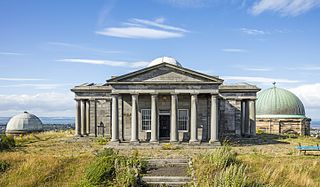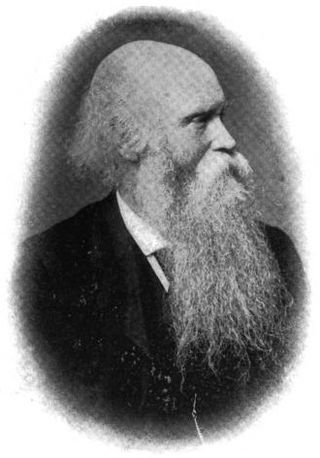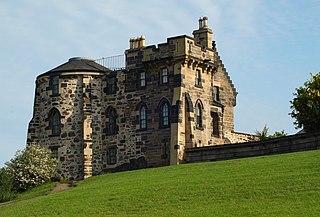
Sir Frank Watson Dyson, KBE, FRS, FRSE was an English astronomer and the ninth Astronomer Royal who is remembered today largely for introducing time signals ("pips") from Greenwich, England, and for the role he played in proving Einstein's theory of general relativity.

Thomas Henderson FRSE FRS FRAS was a Scottish astronomer and mathematician noted for being the first person to measure the distance to Alpha Centauri, the major component of the nearest stellar system to Earth, the first to determine the parallax of a fixed star, and for being the first Astronomer Royal for Scotland.

Sir Alfred Charles Bernard Lovell was an English physicist and radio astronomer. He was the first director of Jodrell Bank Observatory, from 1945 to 1980.

The Royal Astronomical Society (RAS) is a learned society and charity that encourages and promotes the study of astronomy, solar-system science, geophysics and closely related branches of science. Its headquarters are in Burlington House, on Piccadilly in London. The society has over 4,000 members, known as fellows, most of whom are professional researchers or postgraduate students. Around a quarter of Fellows live outside the UK.
Sir Harold Spencer Jones KBE FRS FRSE PRAS was an English astronomer. He became renowned as an authority on positional astronomy and served as the tenth Astronomer Royal for 23 years. Although born "Jones", his surname became "Spencer Jones".

The City Observatory was an astronomical observatory on Calton Hill in Edinburgh, Scotland. It is also known as the Calton Hill Observatory.
William Michael Herbert Greaves FRS FREng FRSE was a British astronomer. He is most noted for his work on stellar spectrophotometry.

Professor Anneila Isabel Sargent FRSE DSc is a Scottish–American astronomer who specializes in star formation.

The Royal Observatory, Edinburgh (ROE) is an astronomical institution located on Blackford Hill in Edinburgh. The site is owned by the Science and Technology Facilities Council (STFC). The ROE comprises the UK Astronomy Technology Centre (UK ATC) of STFC, the Institute for Astronomy of the School of Physics and Astronomy of the University of Edinburgh, and the ROE Visitor Centre.
The Regius Chair of Astronomy is a Regius Professorship in the University of Glasgow.

Ralph Copeland FRSE FRAS was an English astronomer and the third Astronomer Royal for Scotland.

The Manchester Astronomical Society is an organisation that promotes popular and amateur astronomy in North West England. It is one of the oldest provincial astronomical societies in England. The Society is based in the Godlee Observatory located in the Sackville Building, University of Manchester, in Manchester city centre. Membership is open to anyone with an interest in astronomy.

Airdrie Public Observatory is a fully operational, historic astronomical observatory, which is part of the library building in the town of Airdrie, North Lanarkshire, Scotland. There are only four public observatories operating in the United Kingdom, all of which are in Scotland. Airdrie Observatory is the smallest, and second oldest.

Hermann Alexander Brück CBE FRSE was a German-born astronomer, who spent the great portion of his career in various positions in Britain and Ireland.

Mills Observatory is the first purpose-built public astronomical observatory in the UK, located in Dundee, Scotland. Built in 1935, the observatory is classically styled in sandstone and has a distinctive 7 m dome, which houses a Victorian refracting telescope, a small planetarium, and display areas. The dome is one of two made from papier-mâché to survive in the UK, the other being at the Godlee Observatory.

The Edinburgh Astronomical Institution was founded in 1811 and wound up in 1847. It was instrumental in the foundation of the Royal Observatory, Edinburgh in 1822. The Institution raised funds, mostly by member subscription, to create three departments: A scientific observatory with an observer was to be under the control of the professors of mathematics, philosophy and astronomy of the University of Edinburgh, a popular observatory was to provide general instruction and amusement and a "physical cabinet" would comprise books, globes, meteorological and other instruments.

Sir William PeckFRSE FRAS was a Scottish astronomer and scientific instrument maker.
William Marshall Smart was a 20th-century Scottish astronomer.

The Astronomical Society of Glasgow (ASG) was founded in 1954 in Glasgow, Scotland, by amateur astronomers and is dedicated to promoting an interest in Astronomy.
Mary Teresa Brück was an Irish astronomer, astrophysicist and historian of science, whose career was spent at Dunsink Observatory in Dublin and the Royal Observatory Edinburgh in Scotland.
















